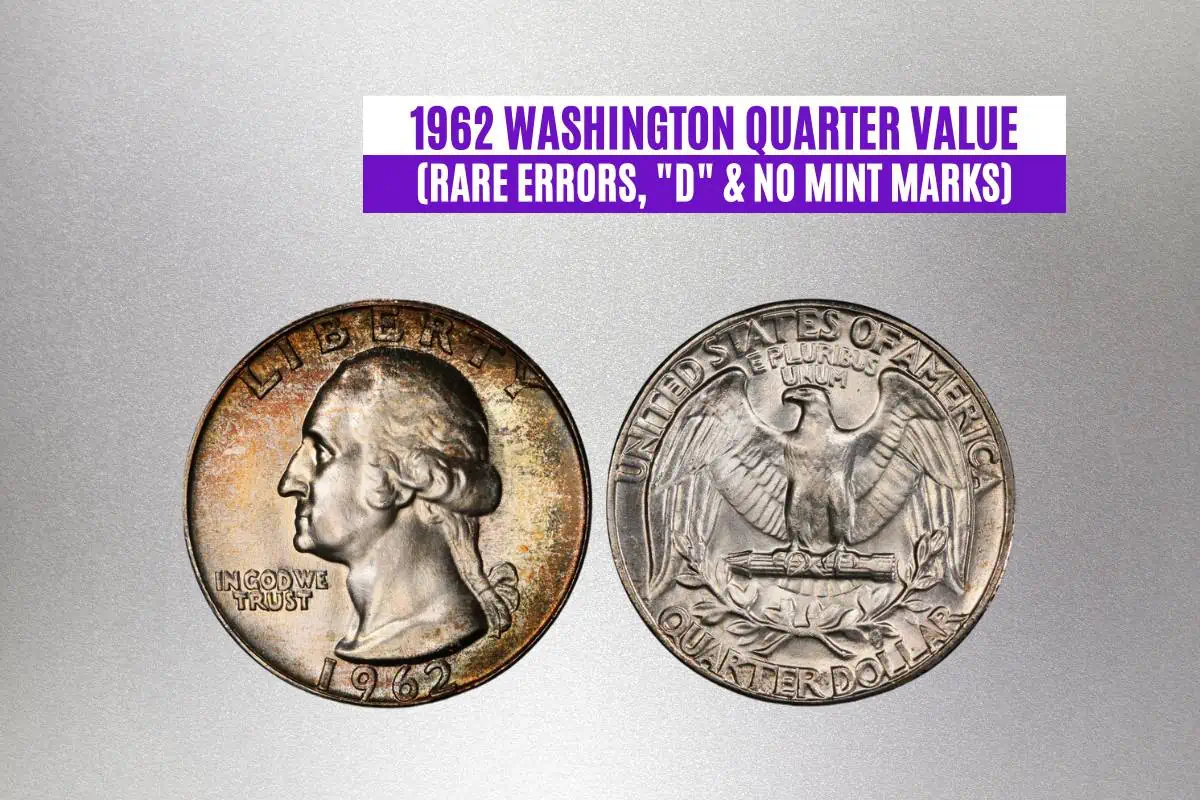The U.S. quarter gets its name from its worth; $0.25, otherwise known as a quarter of a dollar. But did you know some quarters are worth far more than their listed denomination? The 1962 Washington quarter, for example, is far more valuable than the quarters produced today.
In this guide, we’ll discuss the values of these coins and determine which 1962 Washington quarters are the most (and least) valuable. You can use this information to sell or buy these coins at a fair price!
1962 Washington Quarter Value Chart
| Variety | MS/PR-63 | MS/PR-65 | MS/PR-67 |
| 1962-P Quarter | $17.5 | $30 | $2,750 |
| 1962-D Quarter | $17.5 | $30 | $8,750 |
| 1962-P Proof Quarter | $15 | $25 | $35 |
| 1962-P Proof Quarter CA | / | $27.5 | $40 |
| 1962-P Proof Quarter UC | / | $30 | $50 |
1962 Washington Quarter: History
Although the U.S. Mint began creating coinage in 1793, courtesy of the Coinage Act of 1792, it didn’t start making quarters until 1796. These early twenty-five-cent pieces were made of silver and featured the Draped Bust design.
But the design for the $0.25 U.S. changed dramatically throughout the years, with few designs lasting more than a few decades or so. In fact, the initial Draped Bust quarter only lasted for 11 years!
The Washington quarter, introduced in 1932, followed the path laid out by Victor David Brenner’s Lincoln Wheat cent design, showing the image of a beloved U.S. President on the coin’s obverse (front) side. Future coin designs, from the Jefferson nickel to the Roosevelt dime, would follow suit.
The 1962 Washington quarter had far more in common with the earliest U.S. quarters than the $0.25 coins minted today. In fact, it was one of the last quarters produced by the U.S. Mint that contained a significant amount of silver.
By 1965, quarters contained zero silver, making them less valuable than the quarters that came before.
1962 Washington Quarter: Design
The design for the 1962 Washington quarter is attributed to John Flanagan, an American sculptor who also designed medals for the U.S. military and various international events and groups.
Flanagan created the design for the Washington quarter in the early 1930s. It was officially adopted in 1932 (replacing the Standing Liberty quarter). This design saw only minute design changes between 1932 and 1998, making it the longest-lived design for any U.S. quarter coin.
This design was officially retired in 2022 and replaced with Laura Gardin Fraser’s American Women quarters (also called George Washington bust quarters) until 2025.
1962 Washington Quarter Obverse
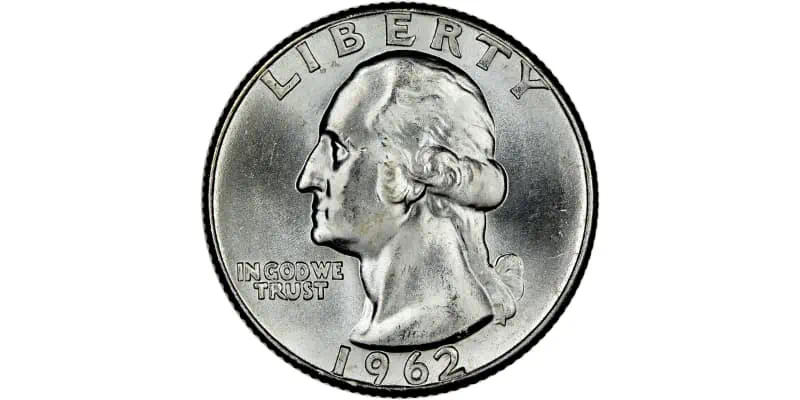
When you look at the front (obverse) side of the 1962 Washington quarter, you’ll see:
- The legend “LIBERTY” along the upper part of the coin
- The raised image (device) of George Washinton, face in profile facing left
- The motto “IN GOD WE TRUST” on the lower left-hand side of the coin, parallel with Washington’s neck
- The year date (1962) on the bottom part of the coin
1962 Washington Quarter Reverse
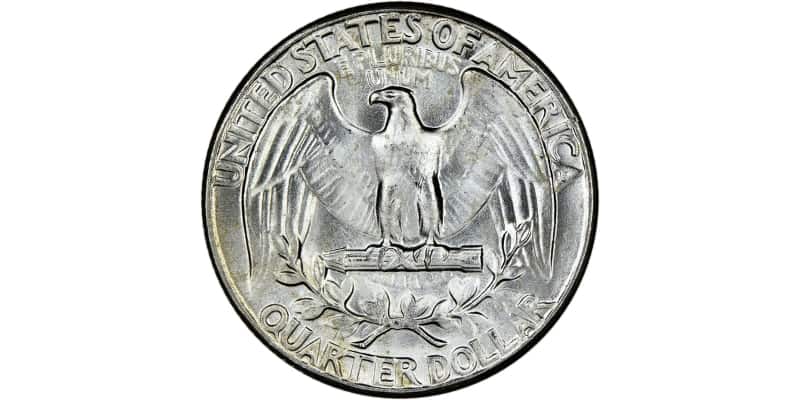
When you look at the back (reverse) side of the 1962 Washington quarter, you’ll see:
- The issuing nation “UNITED STATES OF AMERICA” on the upper part of the coin
- The motto “E PLURIBUS UNUM” beneath the issuing nation
- The raised image (device) of a perched eagle, wings outspread
- The denomination “QUARTER DOLLAR” on the lower part of the coin
1962 Washington Quarter: Features and Specifications
The 1962 Washington quarter is primarily identifiable via its design, with the only changing element being the presence or absence of a mint mark on the coin’s reverse face.
However, design isn’t the only aspect all 1962 Washington quarters have in common. These coins also share some traits, including metal composition, weight, and size.
For example, 1962 Washington quarters are:
- Composed of 90% silver and 10% copper
- Weigh 6.3 grams (about 0.22 ounces)
- 24.3 millimeters (about 0.96 inches) in diameter
Additionally, quarters have a distinct edge type. Unlike pennies, which have round (plain) edges, quarters have a ridged (reeded) edge. This texture sets quarters apart from pennies and nickels and makes them slightly similar to dimes.
How Much Is a 1962 Quarter Worth?
The 1962-P (No Mint Mark) Washington quarter is worth about $4.35 in good (G-4) condition. In about uncirculated (AU-50) condition, this coin has an estimated value of $4.85. An uncirculated (mint state) 1962-P Washington quarter with a grade of MS-68 is worth $4,500 or more.
1962 Washington Quarter: Value Comparison
The U.S. Mint struck more than 100 million Washington quarters in 1962. Some of these quarters were produced at the Philadelphia Mint facility, while others were struck at the Denver Mint.
Those from the Philadelphia Mint don’t feature a mint mark on their reverse sides, while those made at the Denver Mint have a small “D” sandwiched between the denomination (QUARTER DOLLAR) and perched eagle device. Notably, the Philadelphia Mint was the only U.S. Mint facility that produced proof strike quarters in 1962.
The value of the 1962 Washington quarter is dependent on three factors:
- The mint mark (indicating rarity)
- The condition of the coin (represented via a PCGS or NGC grade)
- The strike type of the coin (regular strike vs. proof strike)
Although all 1962 Washington quarters had a legal tender value of $0.25 when released, they’re worth far more nowadays. The value of coins varies between $4.35 and $11,250!
Let’s explore the three types of 1962 Washington quarters to discover which of these twenty-five-cent pieces is the most valuable.
1962-P No Mint Mark Washington Quarter Value
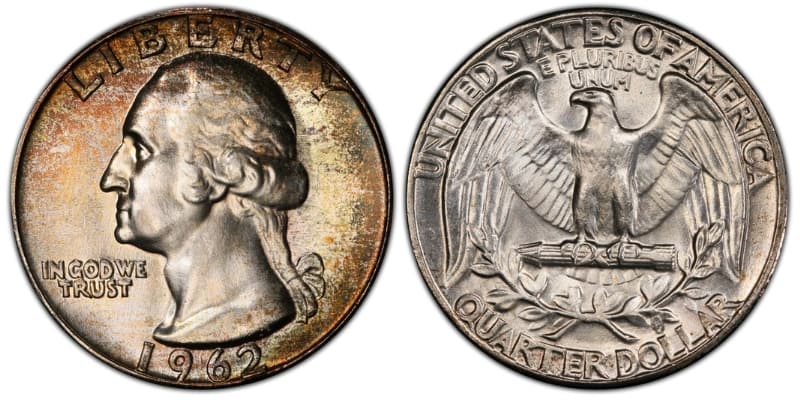
The Philadelphia Mint struck more than 36 million Washington quarters in 1962. None of these coins features a mint mark.
The value of a 1962-P (No Mint Mark) Washington quarter varies between $4.35 and $4,500.
1962-P Washington quarters in good (G-4), fine (F-15), or very fine (VF-30) condition are worth about $4.35. But 1962-P quarters in about uncirculated (AU-50) condition have an estimated value of about $4.85, making them slightly more valuable.
Still, the most valuable 1962-P Washington quarters are those in uncirculated (mint state) condition. For example, an MS-60 1962-P quarter is worth about $10, and an MS-67 1962-P quarter is worth about $2,750.
If you’re fortunate enough to own an MS-68 1962-P (No Mint Mark) Washington quarter, you can expect to sell that coin for at least $4,500. In 2019, an MS-67+ 1962-P Washington quarter sold at auction for $26,400!
1962-D Washington Quarter Value
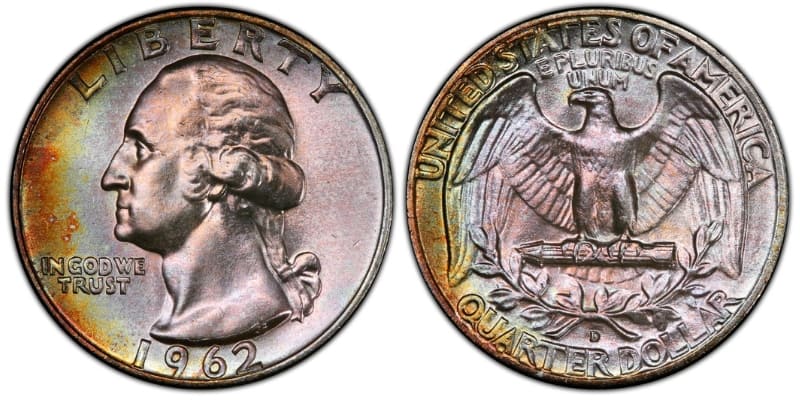
The Denver Mint struck more than 127 million Washington quarters in 1962. Consequently, 1962 quarters featuring a small “D” mint mark are far more common than “No Mint Mark” quarters.
The value of a 1962-D Washington quarter varies significantly depending on its condition. While good (G-4), fine (F-15), and very fine (VF-30) 1962-D quarters have an estimated value of about $4.35, an about uncirculated (AU-50) 1962-D Washington quarter is worth about $4.85.
Still, like 1962-P Washington quarters, the highest-value 1962-D Washington quarters are those in uncirculated (mint state) condition. An MS-60 1962-D quarter is worth about $10, while an MS-67 1962-D quarter is worth about $8,750.
The most valuable 1962-D Washington quarter is one with an MS-67+ grade. One of these quarters can sell for $11,250 or more.
Overall, these quarters are slightly more valuable (on average) than 1962-P Washing quarters, despite their greater commonness.
1962-P Proof Washington Quarter Value
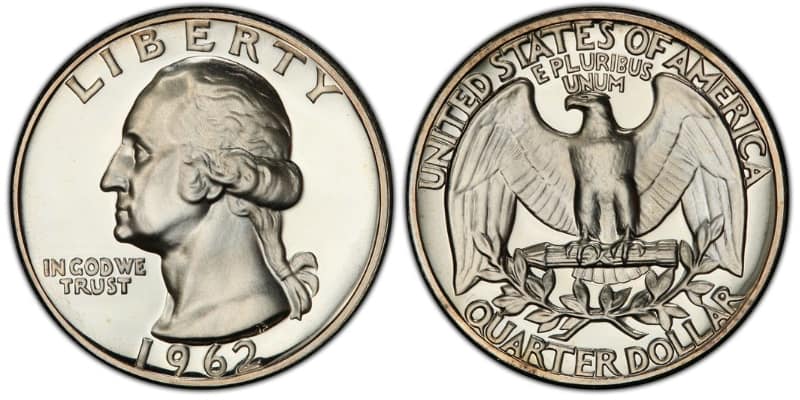
Proof strike coins are explicitly made for collection purposes, so they’re almost always in uncirculated condition. Additionally, the coin dies used to create proof coins are far more detailed and perfected than those used to create regular strike (for-circulation) coins.
As a result, 1962 proof strike quarters exhibit a higher overall quality than regular strike pieces. Although most are a brilliant silver color, these quarters can have an almost gold-like sheen, especially when in near-perfect (PR-65 or higher) condition.
These quarters come in three varieties:
- Proof
- Proof Cameo
- Proof Ultra Cameo (also called Deep Cameo)
The value of each proof strike 1962-P Washington quarter varies depending on its grade and type.
Proof
A proof 1962-P Washington quarter is worth $5 in PR-60 condition, but it can be worth up to $250 in PR-70 condition (the highest possible grade). A PR-67 proof 1962-P Washington quarter is worth about $35.
This might be surprising news for some coin collectors, as proof coins, particularly those that are several decades old, are often lauded as the most valuable types of coins.
However, it’s crucial to note that proof strike coins are explicitly designed for collection. As such, it’s not uncommon to find these coins in one exceptional condition. On the other hand, circulated (regular strike) coins are much more challenging to find at higher grades, making them rarer and more valuable than most proof strike coins.
Still, there’s a bit of a hierarchy in the proof strike coin category. Cameo and ultra cameo (or deep cameo) Washington quarters can be far more valuable than non-cameo proof quarters.
Proof Cameo
Cameo proof coins have tonal differences that make them easy to identify. Cameo coins tend to have dark backgrounds (fields) and lighter raised images and mottos (devices). This gives them a slight two-shade look.
A PR-64 cameo proof 1962-P Washington quarter is worth $22.50, while a PR-67 has an estimated value of about $40.
The most valuable cameo 1962-P proof strike Washington quarters are those with a PR-69 grade. These coins can sell for upwards of $215.
Proof Ultra Cameo
The primary difference between cameo and ultra cameo coins is the tonal difference between the devices (the raised portions of the coin) and the fields (the flat backgrounds). In ultra cameo coins, the raised portions can appear extremely light, almost frosted, while the fields can appear almost black.
The proof strike 1962-P Washington quarter with an ultra cameo finish can sell for between $25 (PR-64) and $550 (PR-69). Fewer than 200,000 ultra cameo proof strike 1962 Washington quarters have a grade of PR-65 or higher.
1962 Washington Quarter: Rare Errors
By the 1960s, the U.S. Mint had essentially perfected its coin production process, resulting in far fewer errors. That said, there are typically at least a handful of error coins that arise from each year’s mintage.
The 1962 Washington quarter saw a few types of rare errors, including the:
- 1962 Washington Quarter Doubled Die Reverse (DDR) Error
- 1962 Washington Quarter Doubled Die Obverse (DDO) Error
- 1962-D Washington Quarter Repunched Mint Mark (RPM) Error
Many error coins can outsell their standard regular strike, error-free counterparts. These make them highly valuable collection pieces!
1962 Washington Quarter Doubled Die Reverse (DDR) Error
This error coin is identifiable via the doubling of design elements on its reverse (back) face.
This doubling might appear as mottos, devices, or legends that seem stacked on top of one another. DDR Washington quarters from 1962 can sell for between $20 and $70.
1962 Washington Quarter Doubled Die Obverse (DDO) Error
The 1962 Doubled Die Obverse (DDO) Washington quarter is similar to the Doubled Die Reverse (DDR) 1962 Washington quarter, but instead of the doubled design elements being on the reverse side of the coin, they’re on the obverse (front) side.
DDO 1962 Washington quarters tend to be more valuable than their DDR counterparts, with many selling for hundreds of dollars. In July 2016, an MS-66+ 1962-P Washington quarter sold at auction for $3,290!
1962-D Washington Quarter Repunched Mint Mark (RPM) Error
Another type of error coin to watch out for is the Repunched Mint Mark (RPM) 1962-D Washington quarter.
These feature a “D” mint mark (on the coin’s reverse) that appears slightly doubled or overlapped. An RPM 1962-D Washington quarter can sell for between $100 and $200, depending on its condition.
Frequently Asked Questions
Do you have additional questions about the 1962 Washington quarter? If so, check out the frequently asked questions below. There’s always more to learn about this $0.25 piece!
Are 1962 Washington Quarters Made of Pure Silver?
Although 1962 Washington quarters are primarily made of silver, they’re not entirely composed of silver.
1962 Washington quarters, regardless of where they were minted or what type of strike they are (regular or proof), consist of 90% silver and 10% copper, making them inherently more valuable than quarters made today (which contain no silver).
How Many 1962 Washington Quarters Exist?
The U.S. Mint produced about 163.7 million regular strike (for-circulation) Washington quarters in 1962. That same year, they created just over 3 million proof strike quarters.
Today, it’s estimated that about 16.371 million regular strike Washington quarters (across all grades) remain, while only about 1.15 million proof strike quarters are left. In terms of regular strike pieces, this represents a reduction of 90%.
About 64% of all proof quarters struck in 1962 no longer exist. More than likely, these coins’ high silver and copper content is the primary reason they’ve become increasingly scarce. After all, the base values of these metals far exceed the quarter’s denomination of $0.25.
What’s the Highest Price Ever Paid for a 1962 Washington Quarter?
The highest auction price ever recorded for a 1962 Washington quarter (non-error) is $26,400. This record was set in March 2019 by an MS-67+ 1962-P (No Mint Mark) Washington quarter. This final price is more than 105,000 times the original listed worth of the coin ($0.25).
Final Thoughts
The 1962 Washington quarter is dramatically different from today’s quarters. For example, these coins contained one of Earth’s most precious materials: silver. Coins produced today are primarily copper, with no trace of silver in them.
A 1962 Washington quarter is worth between $4.35 and $11,250, depending on where it was created (i.e., its mint mark) and its condition. Strike type (regular or proof) also impacts value.
Are you an avid coin collector? Looking to start collecting coins? Check out these related articles to learn more about coin values!

